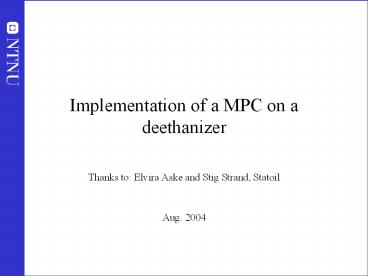Implementation of a MPC on a deethanizer - PowerPoint PPT Presentation
1 / 17
Title:
Implementation of a MPC on a deethanizer
Description:
Implementation of a MPC on a deethanizer Thanks to: Elvira Aske and Stig Strand, Statoil Aug. 2004 MPC implementation at K rst gas processing plant Mainly ... – PowerPoint PPT presentation
Number of Views:22
Avg rating:3.0/5.0
Title: Implementation of a MPC on a deethanizer
1
Implementation of a MPC on a deethanizer
- Thanks to Elvira Aske and Stig Strand, Statoil
- Aug. 2004
2
MPC implementation at Kårstø gas processing plant
- Mainly distillation columns
- In-house MPC technology (SEPTIC)
- Karsto So far 9 distillation column with MPC
11 to go, plus MPC on some other systems, like
steam production.
3
SEPTIC MPC
CV soft constraint y lt ymax RP 0 lt RP lt
RPmax wRP2 in objective
- MV blocking ? size reduction
- CV evaluation points ? size reduction
- CV reference specifications ? tuning flexibility
set point changes / disturbance rejection - Soft constraints and priority levels ?
feasibility and tuning flexibility
4
Stepwise approach for implementation
- Check and possible retuning of the existing
controllers (PID). - Choose CV, MV and DV for the application
- Logic connections to the process interface placed
and tested - Develop estimators
- Model identification. Step tests, (Have used
Tai-Ji ID tool) - Control specifications priorities
- Tuning and model verifications
- Operation under surveillance and operator
training
5
1. Base control (PIDs)
- Stabilize pressure Use vapor draw-off (partial
condenser) - Stabilize liquid levels Use LV-configuration
- Stabilize temperature profile Control
temperature at bottom
- Note This is a multicomponent separation with
non-keys in the bottom, - so temperature changes a lot towards the bottom.
- However, the sensitivity (gain) in the bottom is
small, so this is against - the maximum gain rule ???
- Seems to work in practice, probably because of
update from - estimator
6
2. CV, MV, DV
0 65
65-100
CV
Flare
Fuel gas to boilers
Propane
Feed from stabilizators
DV
Product pumps
MV
MV
Quality estimator
CV
CV
LP Steam
Quality estimator
LP Condensate
To Depropaniser
7
4. Composition (quality) estimators
- Quality estimators to estimate the top and bottom
compositions - Based on a combination of temperatures in the
column - x ?i ki Ti
- Use log transformations on temperatures (T) and
compositions (c) - Coefficients ki identified using ARX model
fitting of dynamic test data. - Typical column
- Binary end (usually top) impurity needs about 2
temperatures in general easy to establish - Multicomponent end (usually bottom) impurity
needs 3-4 temperatures and in general more
difficult to identify test period often needed
to get data with enough variation
8
Temperature sensors
0 65
Deethaniser Train 300
65-100
Flare
Propane
Fuel gas to boilers
Feed from stabilizators
Product pumps
LP Steam
To Depropaniser
LP Condensate
9
Typical temperature test data
10
Top Binary separation in this caseQuality
estimator vs. gas chromatograph
7 temperatures
2 temperatures
little difference if the right temperatures are
chosen
11
5. Step tests/Tai-Ji ID
Reflux
MVs
TC tray 1
C3 in top (estimator)
C2 in bottom (estimator)
CVs
Pressure valve position
12
Step tests/Tai-Ji ID
MV1 Reflux
MV2 T-SP
CV1 C3-top
CV2 C2-btm
CV3 z-PC
13
Model in SEPTIC
MV
Model from MV to CV
CV
prediction
adjustment of lower MV limit
setpoint change
14
6. Control priorities
Results Predicts above SP
MV1
SP Priority 2
Results Predicts above SP
MV2
SP Priority 2
Meet high limit
DV
Limit Priority 1
15
7. Tuning of a CV
Logarithmic transformation of CV
Model
CV in mol
Bias
Tuning parameters
Control targets
16
The final test MPC in closed-loop
CV1
MV1
CV2
MV2
CV3
DV
17
Conclusion MPC
- Generally simpler than previous advanced control
- Well accepted by operators
- Use of in-house technology and expertise
successful































